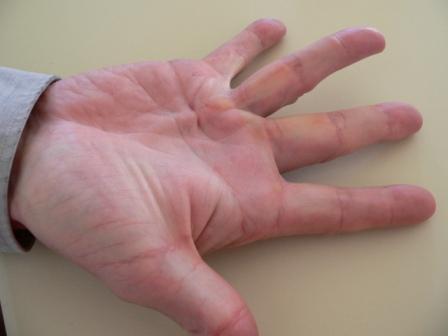Cirrhosis physical examination: Difference between revisions
Jump to navigation
Jump to search
No edit summary |
(→Other) |
||
| Line 58: | Line 58: | ||
* '''Constitutional symptoms''' may be present. These symptoms include [[anorexia]], [[fatigue]], [[weakness]], and [[weight loss]]. | * '''Constitutional symptoms''' may be present. These symptoms include [[anorexia]], [[fatigue]], [[weakness]], and [[weight loss]]. | ||
* '''[[Testicular atrophy]]''' may be present. [[Testes|Male reproductive organs]] diminish in size and may be accompanied by ceasing to function. | * '''[[Testicular atrophy]]''' may be present. [[Testes|Male reproductive organs]] diminish in size and may be accompanied by ceasing to function. | ||
* '''[[Hemorrhoids]]''', ''[[Hematemesis]]'', and ''[[Melena]]'' may be present. | * '''[[Hemorrhoids]]''', '''[[Hematemesis]]''', and '''[[Melena]]''' may be present. | ||
==References== | ==References== | ||
Revision as of 12:40, 7 September 2012
|
Cirrhosis Microchapters |
|
Diagnosis |
|---|
|
Treatment |
|
Case studies |
|
Cirrhosis physical examination On the Web |
|
American Roentgen Ray Society Images of Cirrhosis physical examination |
|
Risk calculators and risk factors for Cirrhosis physical examination |
Editor-In-Chief: C. Michael Gibson, M.S., M.D. [1] ; Associate Editor(s)-in-Chief: Aditya Govindavarjhulla, M.B.B.S. [2]
Overview
Many signs and symptoms may occur in the presence of cirrhosis or as a result of the complications of cirrhosis. Many are nonspecific and may occur in other diseases and do not necessarily point to cirrhosis. Likewise, the absence of any sign or symptom does not rule out the possibility of cirrhosis.
Physical Examination
Skin
- Spider angiomata or spider nevi may be present. Vascular lesions consisting of central arteriole surrounded by many smaller vessels due to an increase in estradiol. These occur in about 33% of cases.[1]
| RT-8OzD9j00}} | -fTGzcsygBI}} |
- Telangiectasia or spider veins may be present. Small dilated blood vessels near the surface of the skin.

- Palmar erythema may be present. Exaggerations of normal speckled mottling of the palm, due to altered sex hormone metabolism.

- Dupuytren's contracture may be present. Thickening and shortening of palmar fascia that leads to flexion deformities of the fingers. Thought to be due to fibroblastic proliferation and disorderly collagen deposition. It is relatively common (33% of patients).


Eyes
- Jaundice. Yellow discoloring of the skin, eye, and mucus membranes due to increased bilirubin (at least 2-3 mg/dL or 30 mmol/L). Urine may also appear dark.
- Kayser-Fleischer rings may be present. Dark rings that appear to encircle the iris of the eye.
Abdomen
- Liver size. Can be enlarged, normal, or shrunken.
- Splenomegaly. Due to congestion of the red pulp as a result of portal hypertension.
- Ascites. Accumulation of fluid in the peritoneal cavity giving rise to flank dullness (needs about 1500 mL to detect flank dullness).
- Caput medusa. In portal hypertension, the umbilical vein may open. Blood from the portal venous system may be shunted through the periumbilical veins into the umbilical vein and ultimately to the abdominal wall veins, manifesting as caput medusa.
- Cruveilhier-Baumgarten murmur. Venous hum heard in epigastric region due to collateral connections between portal system and the remnant of the umbilical vein in portal hypertension.
Extremities
- Hypertrophic osteoarthropathy may be present. Chronic proliferative periostitis of the long bones that can cause considerable pain.
- Nail changes may be present.
- Muehrcke's nails. Paired horizontal bands separated by normal color due to hypoalbuminemia (low production of albumin).
- Terry's nails. Proximal two thirds of the nail plate appears white with distal one-third red, also due to hypoalbuminemia
- Clubbing. Angle between the nail plate and proximal nail fold > 180 degrees
Neurologic
- Asterixis may be present. Bilateral asynchronous flapping of outstretched, dorsiflexed hands seen in patients with hepatic encephalopathy.
{{#ev:youtube|Or65nOrcz1A}}
- Coma can be noticed in cases of encephalopathy.
Other
- Gynecomastia may be present. Benign proliferation of glandular tissue of male breasts presenting with a rubbery or firm mass extending concentrically from the nipples. This is due to increased estradiol and can occur up to 66% of patients.
- Fetor hepaticus may be present. Sweet pungent smell in breath due to increased dimethyl sulfide due to severe portal-systemic shunting.
- Constitutional symptoms may be present. These symptoms include anorexia, fatigue, weakness, and weight loss.
- Testicular atrophy may be present. Male reproductive organs diminish in size and may be accompanied by ceasing to function.
- Hemorrhoids, Hematemesis, and Melena may be present.
References